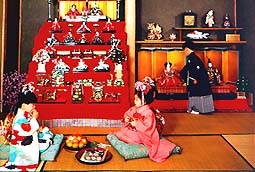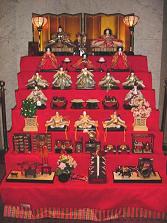We will hold a Tea ceremony and Origami workshop to celebrate the Hinamatsuri or The Doll Festival. Hinamatsuri or Momo no sekku (Peach Festival) is celebrated on 3rd March every year in Japan. On this day, families pray for the growth and happiness of young girls in their household with exhibition hina dolls. The Tea ceremony will be hosted by Ms. Takano, an instructor of Urasenke, and the Origami workshop will be conducted by Ms. Sube.
The dolls will be exhibited at the lobby of JFKL.
Date: 26 (Sun) February 2006
Time:
Session 1, 1:30pm – 3:00pm
Session 2, 2:15pm – 3:45pm
Session 3, 3:00pm – 4:30pm
Session 4, 3:45pm – 5:15pm
Session 5, 4:30pm – 6:00pm
Venue: The Japan Foundation, Kuala Lumpur, Level 30, Menara Citibank, 165, Jalan Ampang, KL
Ticket Fee: RM5 (Tickets are need to be collected by 23 (Thu) February 2006)
*** We can’t accept any walk-in participants
For more enquiries, please contact Ms. Kugai / Ms. Jeslyn at 03-2161 2104 or email to jpcc@jfkl.org.my
How to celebrate?
Families with girls display hina-ningyo ひな人形 (special dolls used for this festival (see photo on the right) and dedicate peach blossoms to them. The peach blossom signifies vitality, eternal youth and peace. These dolls are arranged on five or seven-tiered stand that is covered in red carpet. They represent the emperor, empress, court ladies and attendants in the signature flamboyant robes of the Heian court. A traditional doll set can be very expensive. However these days, we can choose various grades and types of dolls for the set. Unless there is a set handed down from generation to generation, grandparents or parents buy them for the girl on her first Hinamatsuri (hatsu-zekku). There is a superstition that if you don’t put away the hina-ningyo soon after March 3, the daughter will get married late.
Hina-dolls is a scene of the wedding for emperor and empress.
The top: Obina and Mebina (The emperor and the empress,
See the left)
The 2nd step: Sannin-kanjo (Three Court Ladies)
The 3rd step: Gonin-bayashi (Five Musicians)
The 4th step: Zuishin (Two Ministers)
We can see the furniture prepared for the wedding and flowers in other steps.
The dolls wear beautiful ancient court costumes of Heian period (794-1185). The costume of the empress is called juuni-hitoe (twelve-layered ceremonial robe).”
Origami折り紙
The practice of origami began in the early 700s, when paper was first introduced to Japan. At first paper was folded to make decorations for use in religious ceremonies at shrines, but gradually people came to use it in their regular lives as well. During the Heian period (794-1185), it was popular to fold valuable paper and use it to beautifully wrap letters and presents. Later, origami continued to be used in traditional ceremonies, but the women of the imperial court began to fold dolls and other shapes for their amusement.
In the Edo period (1603-1868) people thought up different kinds of origami involving cutting and layering of paper, and the activity grew popular among the common people of Japan. Later, in the Meiji era (1868-1912), origami came to be taught at elementary schools. Students continue to study origami at school to this day; it is used to teach concepts in geometry, such as the relationship between a plane and a solid shape.





